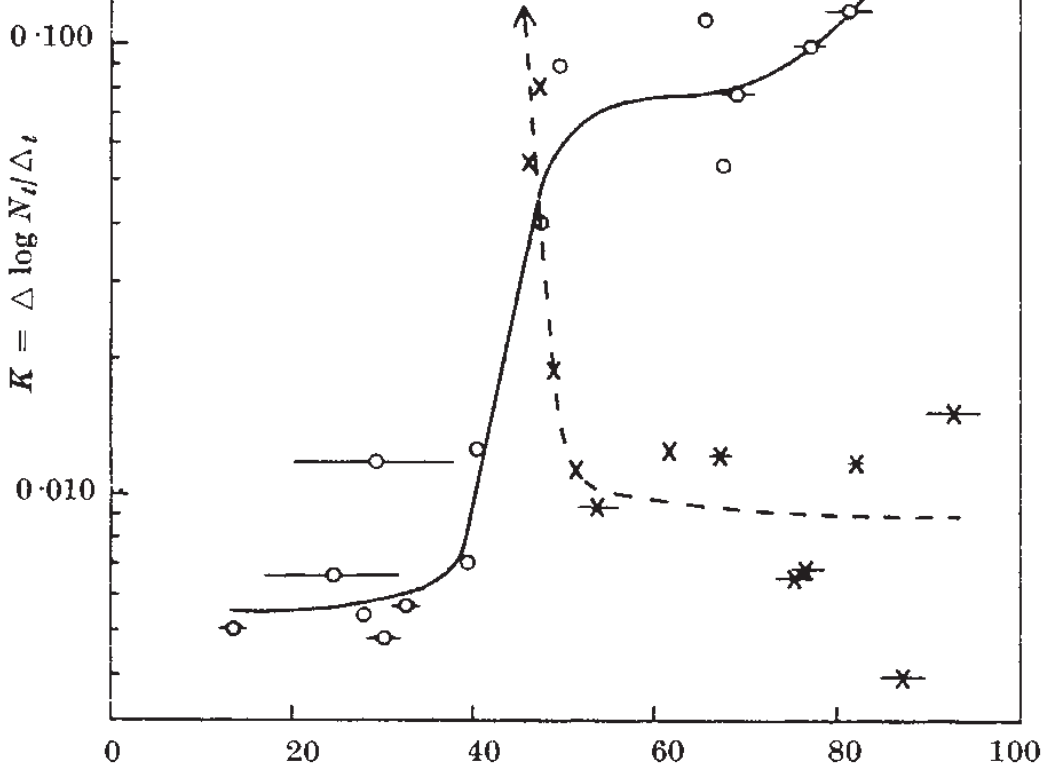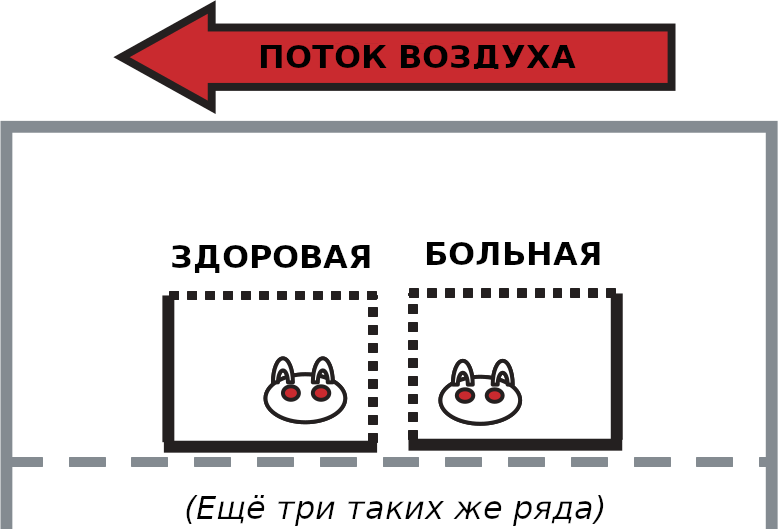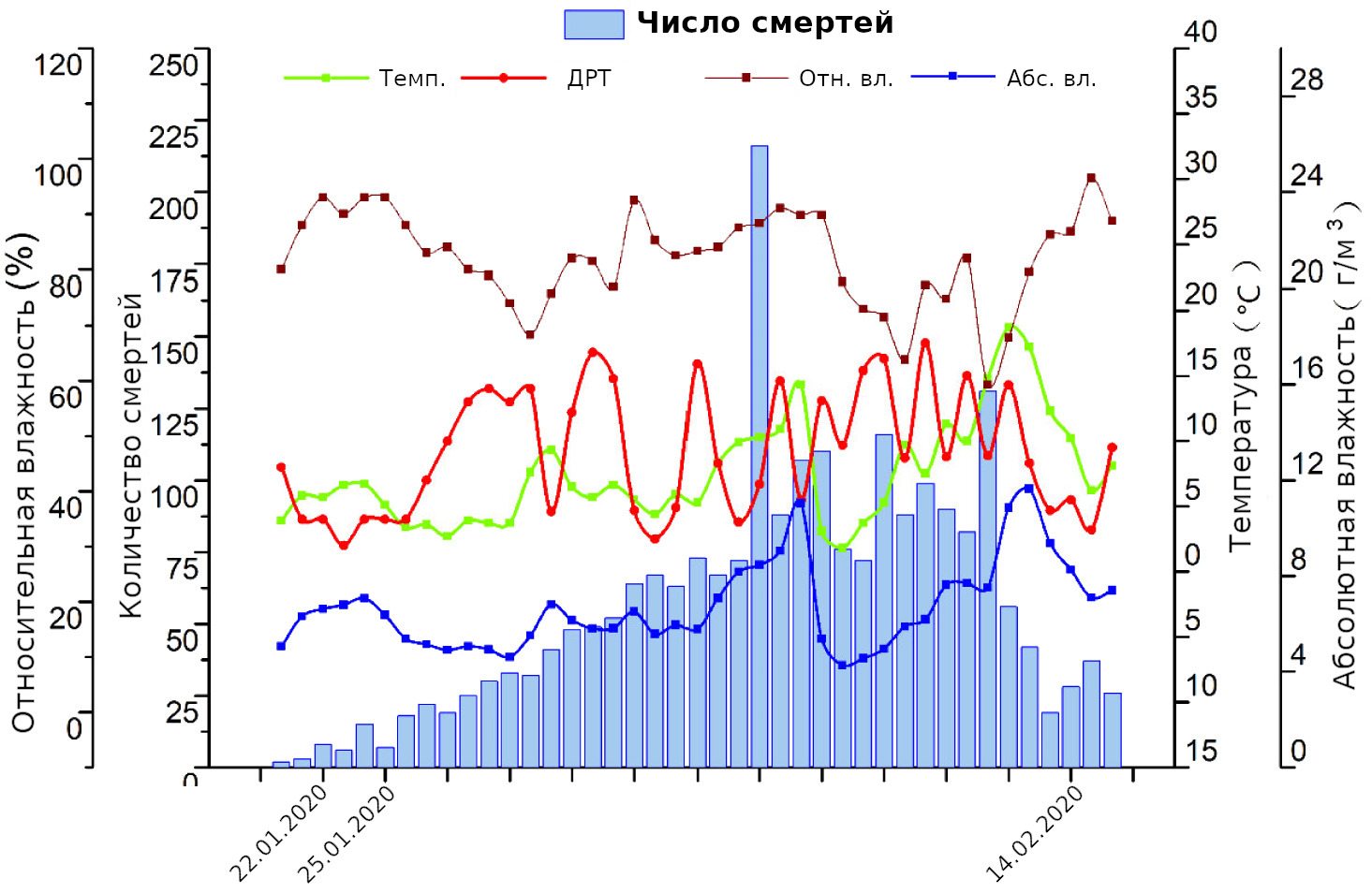Hemmes J. H., et al. Virus Survival as a Seasonal Factor in Influenza and Poliomyelitis, Nature 1960, 188: 430-431.
Experiments have shown that the influenza virus lasts longer in the air at low humidity, and the polio virus - at high humidity. This is consistent with observed influenza activity in winter and polio activity in summer. The first graph in the article shows the rates of inactivation (death) of influenza (\ (\ circ \)) and poliomyelitis (\ (\ times \)) viruses on a logarithmic scale, depending on the relative humidity (in percent):

Harper G. J. Airborne micro-organisms: survival tests with four viruses, Epidemiology & Infection, 1961, 59 (4): 479-486.
, , . . , — . , 64% 24 °C, — 3–4%.
Akers T. G., et al. Airborne stability of simian virus 40 ( SV40 ), Applied microbiology, 1973, 26(2):146–148.
, SV40 ( ). 21 °C ( 22% 88%). 32 °C (50–60%) .
Sohaffer F. L., et al. Survival of Airborne Influenza Virus: Effects of Propagating Host, Relative Humidity, and Composition of Spray Fluids ( : , ), Archives of Virology, 1976, 51(4):263–273.
, , , . , , .
Chew F. T., et al. Seasonal trends of viral respiratory tract infections in the tropics ( ), Epidemiology & Infection, 1998, 121(1):121–128.
1990 1994. - (), . (–) ( , –). , ́ . , . .
Lowen A. C., et al. Influenza Virus Transmission Is Dependent on Relative Humidity and Temperature ( ), PLoS Pathogens, 2007, 3(10):1470–1476.
, ( ) . 20 . 8 :

, , , , 5 °C, 20 °C. 30 °C .
20 °C 20%, 35%, 50%, 65% 80%. 20% 35% ( 3–4 4). 50% . 65% 3 4 , 80% — .
5 °C 50% 80% , 20 °C , .
. -, , . , , 3 . -, ( ). -, , ́ .
Lowen A. C., et al. High Temperature (30 °C) Blocks Aerosol but Not Contact Transmission of Influenza Virus ( (30 °C) , ), Journal of virology, 2008, 82(11):5650–5652.
, , 30 °C 20%, 50%, 65% 80%. .
Shaman J., et al. Absolute humidity modulates influenza survival, transmission, and seasonality ( , ), PNAS, 2009, 106(9):3243–3248
, , . , . , .
, . , . (\(p=0,048\) \(p=0,059\) ), (\(p=0,00027\)).
Shaman J., et al. Absolute Humidity and the Seasonal Onset of Influenza in the Continental United States ( ), PLoS Biology, 2010, 8(2):e1000316.
. , . , .
: , , , — , , , , .
Noti J. D. et al. High Humidity Leads to Loss of Infectious Influenza Virus from Simulated Coughs ( ), PLOS ONE, 2013, 8(2):e57485.
.
, . 4 , . 40% .
Kudo E., et al. Low ambient humidity impairs barrier function and innate resistance against influenza infection ( ), PNAS, 2019, 116(22):10905–10910.
, ( ), , .
Yueling Ma, et al. Effects of temperature variation and humidity on the death of COVID-19 in Wuhan, China ( -19 ), Science of the Total Environment, 2020, 724:138226.
-19 20 29 2020 . () -19:

Yu Wu, et al. Effects of temperature and humidity on the daily new cases and new deaths of COVID-19 in 166 countries ( -19 166 .), The Science of the total environment, 2020, 729:139051.
, . 1 °C 3.08%, 1.19%. 1 — 0,85% 0,51% .
Sajadi M. M., et al. Temperature, Humidity, and Latitude Analysis to Estimate Potential Spread and Seasonality of Coronavirus Disease 2019 (COVID-19) ( , -19), JAMA Network Open, 2020, 3(6):e2011834.
50 10 2020 . 8 -19 42 , -19. , 10 -19 10 2020 .
8 ( , , ́ , , , , , ) 30 ° 40 ° , : 5–11 °C, 4–7 \(\text{/}^3\).
, -19 .
Günther Th., et al. Investigation of a superspreading event preceding the largest meat processing plant-related SARS-Coronavirus 2 outbreak in Germany ( , -19 ), Social Science Research Network, 2020-07-23.
The graph, the spatial arrangement of workers, climatic conditions and ventilation, transport and living conditions were analyzed, a complete analysis of the genome of viruses was carried out. It was found that the transmission of infection took place in a closed room in which the air was constantly circulated and cooled to 10 ° C. The transmission of the virus among employees was carried out within three working days, starting with one of them. The virus was transmitted over a distance of more than 8 meters. All employees were required to wear masks and keep their distance.